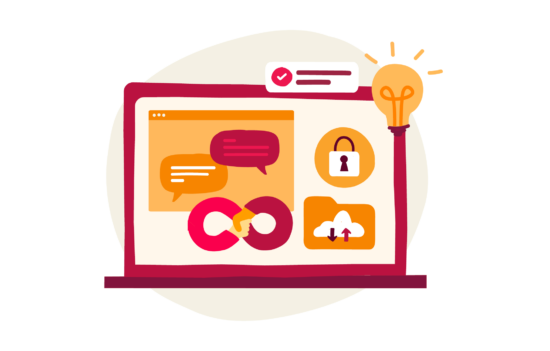If you’re in HR, running an SMB can feel like balancing a dozen spinning plates.
From managing day-to-day tasks to planning for growth, every decision is crucial.
Take a moment to think—how much time and energy do most SMBs spend on HR tasks? And what proportion of their overall time, money, and effort do they spend on them—especially when HR teams at SMBs are often just one or two people.
In addition to all of that, SMB owners often get so busy running their businesses, they may delay implementing solutions to improve internal processes.
But one thing is certain: The more help you can get, the better.
If you’re running the HR show solo or with just one administrative assistant at an SMB, keeping up with the workload can feel impossible without automation.
Sure, you can outsource the work—but that can be triple the cost.
So what’s the solution?
“It’s cheaper to have an HCM to centralize data than worry about veracity, going to different people, having no central point of reference on staff. And what happens to the business if that central (solo) HR person leaves? The mission-critical data leaves with them,” says Karen Longest, SMB people operations expert and HR tech consultant at Longest Lasting Solutions.
“Data integrity and being able to make decisions that work best for the company regarding the business’s strategic direction can’t be done without quality data,” continues Longest. “This is where your HCM comes in: The business has a problem but no visibility into why or how to solve it without people data. At an SMB, an HCM is HR’s best friend.”
With all of this in mind, let’s take a look at exactly how an HCM can be a game-changer for SMB leaders.
<<Simplify HR processes with an HCM built for SMBs. Download your free guide now.>>
What is an HCM?
Let’s start with the basics.
Human capital management (HCM) is an approach to managing and optimizing an organization’s most valuable asset: its people.
An HCM system integrates your processes, from recruitment and onboarding to payroll, training, and performance management, into a single, unified platform.
By automating or streamlining these processes, an HCM gives HR leaders the freedom to better manage every stage of the employee experience and make sure everything aligns with business goals.

What can a great HCM help SMBs achieve?
Human capital management (HCM) systems for SMBs are a great way to maximize your resources. They can essentially act as another member of your team. By automating repetitive, time-consuming tasks, an HCM can free up your time to focus on strategic, people-centric HR initiatives.
But that’s not all they can do. For SMBs with limited resources, here’s what a great HCM can achieve:
- Boosted team efficiency and time savings. By automating repetitive HR tasks like payroll processing, time tracking, and benefits administration, an HCM reduces the need for manual work.
- Fewer mistakes and improved data accuracy. When you’re juggling multiple spreadsheets or piecing together data from different apps, mistakes are bound to happen. An HCM keeps all your people data in one place, reducing the risk of errors that can impact payroll, compliance, or data accuracy.
- Increased value from your people team. When an HCM takes over the heavy lifting for admin tasks, your people team can shift their focus to strategic, impactful work. With an HCM, people teams become a core part of business success.
- Data that drives better decision-making. With all your people data centralized and easy to access, you get insights that drive better decisions. An HCM helps you spot trends, track progress, and address challenges like turnover or engagement proactively—so you can build strategies based on solid data and give your business the foresight to adapt and thrive.
- An integrated tech stack for smoother workflows. Many SMBs rely on a mix of tools that aren’t always built to work together. HCM systems for small businesses integrate smoothly with other platforms, like payroll, communication tools, and performance management, giving you a connected and reliable experience. No more switching between apps or tracking down data—your HCM keeps it all under one roof.
- Cost-effective and scalable HR solutions. By unifying your tools under an HCM, you can cut down on multiple software subscriptions and reduce maintenance headaches. This simplicity lowers costs, supports scalability, and provides a tech foundation that grows with you, rather than against you.
- A more engaged and resilient team. Self-service options, transparent data, and built-in career development tools make life easier and more fulfilling for your team members. With an HCM, you’re creating a workplace where people can grow, stay connected, and be ready to tackle whatever comes next.
Get leadership buy-in with insights from your HCM
Making the case for a new system as an HR professional at an SMB can be tough. But lean on the data you have to make your case. It’ll speak for itself.
And once you’ve made your case, more powerful data is exactly what an HCM can deliver.
With real-time insights into critical areas like compliance, time saved, and team satisfaction, HCMs aren’t just for day-to-day tasks: They provide the hard evidence that helps leadership see the impact and value of HR programs.
They help you show decision-makers exactly how much time and money your business saves by reducing payroll errors, improving data security, increasing employee engagement, or automating manual tasks.
HCMs help SMBs tackle some of their most pressing challenges. Tap into the power of an HCM, all while proving the ROI to get leadership buy-in, to:
Automate manual processes as your business scales
For small businesses, manual HR tasks like payroll calculations, attendance tracking, and onboarding can quickly pile up—eating into valuable time that you can spend on growing the business.
Automating these manual processes with an HCM solution is fundamental to helping SMBs scale by removing repetitive, time-consuming work from their plates. Automation also gives HR teams and managers back precious hours to focus on strategic, people-centric tasks.
You can save time and HR hours by moving from manual timesheets and payroll entries to an automated system that tracks hours, processes pay accurately, and handles compliance updates—all in one go. This shift helps eliminate potential errors and provides SMBs with the ability to handle a larger workforce as they grow, without needing a proportional increase in HR resources.
Having automated workflows also means faster, more consistent experiences for everyone across the organization.
For example, having an automated onboarding system ensures that every new joiner has the same standardized, high-quality experience, from receiving the right training modules to completing essential paperwork.
The result is a more efficient and welcoming process that supports a smoother transition as the business expands.
Support growth and manage change
Facing new challenges as a company grows is inevitable, and challenges can include anything from rising attrition rates and fluctuating engagement levels to budget constraints.
All of these make it difficult to scale sustainably while keeping your people engaged and satisfied.
However, if they have access to a comprehensive HCM solution, SMBs can gain the visibility and insights they need to manage these challenges, support team growth, and boost engagement—all without significantly increasing their costs.
Let’s use an example.
An SMB with teams spread across multiple locations is experiencing high turnover rates. One site is seeing attrition among managers and directors, and the other is seeing entry-level team members leaving.
The C-level leaders are dismissing the high rates of attrition as “people just wanting more money,” but the reality is actually far more complex.
Let’s start with site #1.
| Managers and directors, despite being well compensated, feel unsatisfied and are leaving their positions.
Through exit interview data, the HCM shows that they all have similar reasons for leaving: bad experiences with their direct managers, a bad work-life balance, and the direction the company was taking didn’t align with their values. With this information on hand, HR leaders can implement targeted manager training programs, strengthen alignment on company vision, and invest in support programs that meet people’s needs, ultimately reducing turnover and increasing satisfaction. |
Now let’s take a look at site #2.
| Entry-level team members are leaving the company because they’re not getting paid enough and they feel they have limited career development options.
The HCM’s data helps identify these issues, leading to the creation of professional growth programs and transparent compensation benchmarking so new team members can see the potential for upward mobility and, therefore, a future at the company. In both scenarios, insights from the HCM empower you to take proactive action—reducing attrition, maintaining morale, and making sure the organization remains on track for healthy, sustained growth—without budget strain. |
Champion employee self-service
Giving your people the freedom to manage routine tasks themselves is a clear-and-simple win-win scenario.
With the right HCM, every team member at every site in your organization can access and update their information at their own pace—whether that’s checking pay stubs, adjusting contact details, or even tracking their leave balances.
Having this kind of flexibility and accessibility makes it far simpler for people to get what they need, as they don’t need to go through HR. It’s an easy win for boosting satisfaction and saving time.
But these self-service tools don’t just make things easier for your people: They also free up HR leaders to focus on higher-impact tasks. Instead of taking time out of their days to handle requests, HR can focus their expertise on people-centric strategies like people development, engagement, and organizational planning.
This shift in focus can make a huge difference to HR’s ability to act as a strategic partner and serve the business proactively, keeping costs down while still meeting people’s needs.
Consolidate your tech stack and secure workforce data
For fast-growing businesses, an integrated HCM system offers a powerful way to streamline daily workflows, cut costs, and create a secure, data-rich ecosystem.
Juggling multiple point solutions to cover time tracking, compliance, and everything in between can be costly and messy. And in most cases, those tools rarely “talk” to each other easily, meaning you’re often dealing with scattered data and double entries.
That’s where a good HCM can really shine.
It can handle core HR functions, securely house data, and even support integrations with your favorite third-party apps. With everything in one place, you can get a much clearer view of your people data without the hassle of constantly switching between systems.
Plus, having fewer platforms means stronger security and less chance of data slipping through the cracks.
Top HCMs also have advanced security features built in, like end-to-end encryption and customized permissions, so your people’s information stays safe and only accessible to those who need it.
Stay compliant around the world
Global compliance for SMBs can be a tricky task.
Each country has its own set of rules on data security, pay equity, work conditions, and environmental practices. Regulations are also constantly evolving, which can be a real headache for HR professionals trying to keep track.
When you invest in a reliable HCM, you’re investing in a great way to manage everything from GDPR requirements in the EU to new CSR reporting rules in the UK.
You can store and track all your compliance data in one secure spot—making it easy to adapt as new laws roll out. Your HCM can also keep tabs on valuable metrics like pay transparency and diversity ratios, helping make sure you’re creating a fair and equitable workplace.

Show you value your people with fair and accurate payroll and compensation management
It’s no secret that people want to feel valued for their efforts.
Making sure you have fair and accurate payroll that always delivers is a big part of making sure that happens. After all, transparent pay practices reinforce trust and show your people that you truly care about their time and effort.
However, payroll can sometimes feel challenging, especially for SMBs that are balancing compliance, diverse pay scales, and benefits across regions.
With the right HCM, payroll gets a lot simpler. Automated processes mean fewer costly errors, better compliance with local regulations, and insights that help you keep pay fair across the board.
When your people see that your pay practices are consistent and equitable, they’re far more likely to feel valued and engaged, helping you boost overall satisfaction and retention.
Recommended For Further Reading
Make data-based decisions to achieve more, faster
To stay competitive, SMBs need tools that help them achieve more with fewer resources.
By investing in HCM implementation for small businesses, you’re investing in a partner to drive smart, data-based decisions that fuel growth, create a positive workplace, and improve day-to-day operations.
Investing in an HCM means equipping your business to adapt quickly, scale sustainably, and build a workplace that prioritizes productivity and people—equally—keeping everyone on track for the road ahead.
A smarter way to handle HR
Running HR in an SMB means wearing many hats, and balancing administrative tasks with creating a thriving workplace culture is one of the trickier jobs to juggle.
That’s where an HCM comes in.
Having access to an effective, efficient HCM is a great way to lighten the load, simplify your processes, and give your people the support they deserve.
Lean on an HCM to automate tasks, keep your data reliable, get buy-in for people programs from your peers in company leadership, and make smarter decisions so you have the time to focus on what really matters—growing your business and taking care of your team.
<<Simplify HR processes with an HCM built for SMBs. Download your free guide now.>>

